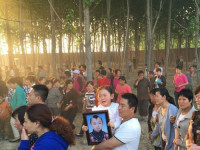Fine-tuning a Pretrained Network for Style Recognition
来源:互联网 发布:淘宝网注册企业店铺 编辑:程序博客网 时间:2024/06/06 09:21
实验一
首先写一下下面这个.py
caffe_root = './caffe/' # this file should be run from {caffe_root}/examples (otherwise change this line)import syssys.path.insert(0, caffe_root + 'python')import caffecaffe.set_device(0)caffe.set_mode_gpu()import numpy as npfrom pylab import *#matplotlib inlineimport tempfile# Helper function for deprocessing preprocessed images, e.g., for display.def deprocess_net_image(image): image = image.copy() # don't modify destructively image = image[::-1] # BGR -> RGB image = image.transpose(1, 2, 0) # CHW -> HWC image += [123, 117, 104] # (approximately) undo mean subtraction # clamp values in [0, 255] image[image < 0], image[image > 255] = 0, 255 # round and cast from float32 to uint8 image = np.round(image) image = np.require(image, dtype=np.uint8) return image接着运行下面三条命令下载数据。
sudo ./data/ilsvrc12/get_ilsvrc_aux.shsudo ./scripts/download_model_binary.py models/bvlc_reference_caffenesudo python ./examples/finetune_flickr_style/assemble_data.py \ --workers=-1 --seed=1701 \ --images=2000 --label=5注意,我这里的话,运行第三条命令出错。
我们需要把assemble_data.py改成如下
#!/usr/bin/env python3 """ Form a subset of the Flickr Style data, download images to dirname, and write Caffe ImagesDataLayer training file. """ import os import urllib import hashlib import argparse import numpy as np import pandas as pd from skimage import io import multiprocessing import socket # Flickr returns a special image if the request is unavailable. MISSING_IMAGE_SHA1 = '6a92790b1c2a301c6e7ddef645dca1f53ea97ac2' example_dirname = os.path.abspath(os.path.dirname(__file__)) caffe_dirname = os.path.abspath(os.path.join(example_dirname, '../..')) training_dirname = os.path.join(caffe_dirname, 'data/flickr_style') def download_image(args_tuple): "For use with multiprocessing map. Returns filename on fail." try: url, filename = args_tuple if not os.path.exists(filename): urllib.urlretrieve(url, filename) with open(filename) as f: assert hashlib.sha1(f.read()).hexdigest() != MISSING_IMAGE_SHA1 test_read_image = io.imread(filename) return True except KeyboardInterrupt: raise Exception() # multiprocessing doesn't catch keyboard exceptions except: return False def mydownload_image(args_tuple): "For use with multiprocessing map. Returns filename on fail." try: url, filename = args_tuple if not os.path.exists(filename): urllib.urlretrieve(url, filename) with open(filename) as f: assert hashlib.sha1(f.read()).hexdigest() != MISSING_IMAGE_SHA1 test_read_image = io.imread(filename) return True except KeyboardInterrupt: raise Exception() # multiprocessing doesn't catch keyboard exceptions except: return False if __name__ == '__main__': parser = argparse.ArgumentParser( description='Download a subset of Flickr Style to a directory') parser.add_argument( '-s', '--seed', type=int, default=0, help="random seed") parser.add_argument( '-i', '--images', type=int, default=-1, help="number of images to use (-1 for all [default])", ) parser.add_argument( '-w', '--workers', type=int, default=-1, help="num workers used to download images. -x uses (all - x) cores [-1 default]." ) parser.add_argument( '-l', '--labels', type=int, default=0, help="if set to a positive value, only sample images from the first number of labels." ) args = parser.parse_args() np.random.seed(args.seed) # Read data, shuffle order, and subsample. csv_filename = os.path.join(example_dirname, 'flickr_style.csv.gz') df = pd.read_csv(csv_filename, index_col=0, compression='gzip') df = df.iloc[np.random.permutation(df.shape[0])] if args.labels > 0: df = df.loc[df['label'] < args.labels] if args.images > 0 and args.images < df.shape[0]: df = df.iloc[:args.images] # Make directory for images and get local filenames. if training_dirname is None: training_dirname = os.path.join(caffe_dirname, 'data/flickr_style') images_dirname = os.path.join(training_dirname, 'images') if not os.path.exists(images_dirname): os.makedirs(images_dirname) df['image_filename'] = [ os.path.join(images_dirname, _.split('/')[-1]) for _ in df['image_url'] ] # Download images. num_workers = args.workers if num_workers <= 0: num_workers = multiprocessing.cpu_count() + num_workers print('Downloading {} images with {} workers...'.format( df.shape[0], num_workers)) #pool = multiprocessing.Pool(processes=num_workers) map_args = zip(df['image_url'], df['image_filename']) #results = pool.map(download_image, map_args) socket.setdefaulttimeout(6) results = [] for item in map_args: value = mydownload_image(item) results.append(value) if value == False: print 'Download False' else: print 'Download Success' # Only keep rows with valid images, and write out training file lists. print len(results) df = df[results] for split in ['train', 'test']: split_df = df[df['_split'] == split] filename = os.path.join(training_dirname, '{}.txt'.format(split)) split_df[['image_filename', 'label']].to_csv( filename, sep=' ', header=None, index=None) print('Writing train/val for {} successfully downloaded images.'.format( df.shape[0])) 这些要下好久的- -。。。
full_dataset = Falseif full_dataset: NUM_STYLE_IMAGES = NUM_STYLE_LABELS = -1else: NUM_STYLE_IMAGES = 2000 NUM_STYLE_LABELS = 5import osweights = os.path.join(caffe_root, 'models/bvlc_reference_caffenet/bvlc_reference_caffenet.caffemodel')assert os.path.exists(weights)# Load ImageNet labels to imagenet_labelsimagenet_label_file = caffe_root + 'data/ilsvrc12/synset_words.txt'imagenet_labels = list(np.loadtxt(imagenet_label_file, str, delimiter='\t'))assert len(imagenet_labels) == 1000print 'Loaded ImageNet labels:\n', '\n'.join(imagenet_labels[:10] + ['...'])# Load style labels to style_labelsstyle_label_file = caffe_root + 'examples/finetune_flickr_style/style_names.txt'style_labels = list(np.loadtxt(style_label_file, str, delimiter='\n'))if NUM_STYLE_LABELS > 0: style_labels = style_labels[:NUM_STYLE_LABELS]print '\nLoaded style labels:\n', ', '.join(style_labels)接着运行下面的代码
caffe_root = './caffe/' # this file should be run from {caffe_root}/examples (otherwise change this line)import syssys.path.insert(0, caffe_root + 'python')import caffecaffe.set_device(0)caffe.set_mode_gpu()import numpy as npfrom pylab import *#matplotlib inlineimport tempfile# Helper function for deprocessing preprocessed images, e.g., for display.def deprocess_net_image(image): image = image.copy() # don't modify destructively image = image[::-1] # BGR -> RGB image = image.transpose(1, 2, 0) # CHW -> HWC image += [123, 117, 104] # (approximately) undo mean subtraction # clamp values in [0, 255] image[image < 0], image[image > 255] = 0, 255 # round and cast from float32 to uint8 image = np.round(image) image = np.require(image, dtype=np.uint8) return imagefull_dataset = Falseif full_dataset: NUM_STYLE_IMAGES = NUM_STYLE_LABELS = -1else: NUM_STYLE_IMAGES = 2000 NUM_STYLE_LABELS = 5import osweights = os.path.join(caffe_root, 'models/bvlc_reference_caffenet/bvlc_reference_caffenet.caffemodel')assert os.path.exists(weights)# Load ImageNet labels to imagenet_labelsimagenet_label_file = caffe_root + 'data/ilsvrc12/synset_words.txt'imagenet_labels = list(np.loadtxt(imagenet_label_file, str, delimiter='\t'))assert len(imagenet_labels) == 1000print 'Loaded ImageNet labels:\n', '\n'.join(imagenet_labels[:10] + ['...'])# Load style labels to style_labelsstyle_label_file = caffe_root + 'examples/finetune_flickr_style/style_names.txt'style_labels = list(np.loadtxt(style_label_file, str, delimiter='\n'))if NUM_STYLE_LABELS > 0: style_labels = style_labels[:NUM_STYLE_LABELS]print '\nLoaded style labels:\n', ', '.join(style_labels)from caffe import layers as Lfrom caffe import params as Pweight_param = dict(lr_mult=1, decay_mult=1)bias_param = dict(lr_mult=2, decay_mult=0)learned_param = [weight_param, bias_param]frozen_param = [dict(lr_mult=0)] * 2def conv_relu(bottom, ks, nout, stride=1, pad=0, group=1, param=learned_param, weight_filler=dict(type='gaussian', std=0.01), bias_filler=dict(type='constant', value=0.1)): conv = L.Convolution(bottom, kernel_size=ks, stride=stride, num_output=nout, pad=pad, group=group, param=param, weight_filler=weight_filler, bias_filler=bias_filler) return conv, L.ReLU(conv, in_place=True)def fc_relu(bottom, nout, param=learned_param, weight_filler=dict(type='gaussian', std=0.005), bias_filler=dict(type='constant', value=0.1)): fc = L.InnerProduct(bottom, num_output=nout, param=param, weight_filler=weight_filler, bias_filler=bias_filler) return fc, L.ReLU(fc, in_place=True)def max_pool(bottom, ks, stride=1): return L.Pooling(bottom, pool=P.Pooling.MAX, kernel_size=ks, stride=stride)def caffenet(data, label=None, train=True, num_classes=1000, classifier_name='fc8', learn_all=False): """Returns a NetSpec specifying CaffeNet, following the original proto text specification (./models/bvlc_reference_caffenet/train_val.prototxt).""" n = caffe.NetSpec() n.data = data param = learned_param if learn_all else frozen_param n.conv1, n.relu1 = conv_relu(n.data, 11, 96, stride=4, param=param) n.pool1 = max_pool(n.relu1, 3, stride=2) n.norm1 = L.LRN(n.pool1, local_size=5, alpha=1e-4, beta=0.75) n.conv2, n.relu2 = conv_relu(n.norm1, 5, 256, pad=2, group=2, param=param) n.pool2 = max_pool(n.relu2, 3, stride=2) n.norm2 = L.LRN(n.pool2, local_size=5, alpha=1e-4, beta=0.75) n.conv3, n.relu3 = conv_relu(n.norm2, 3, 384, pad=1, param=param) n.conv4, n.relu4 = conv_relu(n.relu3, 3, 384, pad=1, group=2, param=param) n.conv5, n.relu5 = conv_relu(n.relu4, 3, 256, pad=1, group=2, param=param) n.pool5 = max_pool(n.relu5, 3, stride=2) n.fc6, n.relu6 = fc_relu(n.pool5, 4096, param=param) if train: n.drop6 = fc7input = L.Dropout(n.relu6, in_place=True) else: fc7input = n.relu6 n.fc7, n.relu7 = fc_relu(fc7input, 4096, param=param) if train: n.drop7 = fc8input = L.Dropout(n.relu7, in_place=True) else: fc8input = n.relu7 # always learn fc8 (param=learned_param) fc8 = L.InnerProduct(fc8input, num_output=num_classes, param=learned_param) # give fc8 the name specified by argument `classifier_name` n.__setattr__(classifier_name, fc8) if not train: n.probs = L.Softmax(fc8) if label is not None: n.label = label n.loss = L.SoftmaxWithLoss(fc8, n.label) n.acc = L.Accuracy(fc8, n.label) # write the net to a temporary file and return its filename with tempfile.NamedTemporaryFile(delete=False) as f: f.write(str(n.to_proto())) return f.namedummy_data = L.DummyData(shape=dict(dim=[1, 3, 227, 227]))imagenet_net_filename = caffenet(data=dummy_data, train=False)imagenet_net = caffe.Net(imagenet_net_filename, weights, caffe.TEST)def style_net(train=True, learn_all=False, subset=None): if subset is None: subset = 'train' if train else 'test' source = caffe_root + 'data/flickr_style/%s.txt' % subset transform_param = dict(mirror=train, crop_size=227, mean_file=caffe_root + 'data/ilsvrc12/imagenet_mean.binaryproto') style_data, style_label = L.ImageData( transform_param=transform_param, source=source, batch_size=50, new_height=256, new_width=256, ntop=2) return caffenet(data=style_data, label=style_label, train=train, num_classes=NUM_STYLE_LABELS, classifier_name='fc8_flickr', learn_all=learn_all)untrained_style_net = caffe.Net(style_net(train=False, subset='train'), weights, caffe.TEST)untrained_style_net.forward()style_data_batch = untrained_style_net.blobs['data'].data.copy()style_label_batch = np.array(untrained_style_net.blobs['label'].data, dtype=np.int32)def disp_preds(net, image, labels, k=5, name='ImageNet'): input_blob = net.blobs['data'] net.blobs['data'].data[0, ...] = image probs = net.forward(start='conv1')['probs'][0] top_k = (-probs).argsort()[:k] print 'top %d predicted %s labels =' % (k, name) print '\n'.join('\t(%d) %5.2f%% %s' % (i+1, 100*probs[p], labels[p]) for i, p in enumerate(top_k))def disp_imagenet_preds(net, image): disp_preds(net, image, imagenet_labels, name='ImageNet')def disp_style_preds(net, image): disp_preds(net, image, style_labels, name='style')batch_index = 8image = style_data_batch[batch_index]plt.imshow(deprocess_net_image(image))print 'actual label =', style_labels[style_label_batch[batch_index]]plt.show()disp_imagenet_preds(imagenet_net, image)disp_style_preds(untrained_style_net, image)实验二
运行下面代码
import numpy as npimport matplotlib.pyplot as plt#matplotlib inline# Make sure that caffe is on the python path:caffe_root = '/home/lol/dl/caffe/' # this file is expected to be in {caffe_root}/examplesimport syssys.path.insert(0, caffe_root + 'python')import caffe# configure plottingplt.rcParams['figure.figsize'] = (10, 10)plt.rcParams['image.interpolation'] = 'nearest'plt.rcParams['image.cmap'] = 'gray'# Load the net, list its data and params, and filter an example image.caffe.set_mode_cpu()net = caffe.Net(caffe_root + 'examples/net_surgery/conv.prototxt', caffe.TEST)print("blobs {}\nparams {}".format(net.blobs.keys(), net.params.keys()))# load image and prepare as a single input batch for Caffeim = np.array(caffe.io.load_image(caffe_root + 'examples/images/cat_gray.jpg', color=False)).squeeze()plt.title("original image")plt.imshow(im)plt.axis('off')im_input = im[np.newaxis, np.newaxis, :, :]net.blobs['data'].reshape(*im_input.shape)net.blobs['data'].data[...] = im_inputplt.show()def show_filters(net): net.forward() plt.figure() filt_min, filt_max = net.blobs['conv'].data.min(), net.blobs['conv'].data.max() for i in range(3): plt.subplot(1,4,i+2) plt.title("filter #{} output".format(i)) plt.imshow(net.blobs['conv'].data[0, i], vmin=filt_min, vmax=filt_max) plt.tight_layout() plt.axis('off') plt.show()# filter the image with initial show_filters(net)# pick first filter outputconv0 = net.blobs['conv'].data[0, 0]print("pre-surgery output mean {:.2f}".format(conv0.mean()))# set first filter bias to 1net.params['conv'][1].data[0] = 1.net.forward()print("post-surgery output mean {:.2f}".format(conv0.mean()))ksize = net.params['conv'][0].data.shape[2:]# make Gaussian blursigma = 1.y, x = np.mgrid[-ksize[0]//2 + 1:ksize[0]//2 + 1, -ksize[1]//2 + 1:ksize[1]//2 + 1]g = np.exp(-((x**2 + y**2)/(2.0*sigma**2)))gaussian = (g / g.sum()).astype(np.float32)net.params['conv'][0].data[0] = gaussian# make Sobel operator for edge detectionnet.params['conv'][0].data[1:] = 0.sobel = np.array((-1, -2, -1, 0, 0, 0, 1, 2, 1), dtype=np.float32).reshape((3,3))net.params['conv'][0].data[1, 0, 1:-1, 1:-1] = sobel # horizontalnet.params['conv'][0].data[2, 0, 1:-1, 1:-1] = sobel.T # verticalshow_filters(net)接着运行下面命令
diff net_surgery/bvlc_caffenet_full_conv.prototxt ../models/bvlc_reference_caffenet/deploy.prototxt# Load the original network and extract the fully connected layers' parameters.net = caffe.Net(caffe_root + 'models/bvlc_reference_caffenet/deploy.prototxt', caffe_root + 'models/bvlc_reference_caffenet/bvlc_reference_caffenet.caffemodel', caffe.TEST)params = ['fc6', 'fc7', 'fc8']# fc_params = {name: (weights, biases)}fc_params = {pr: (net.params[pr][0].data, net.params[pr][1].data) for pr in params}for fc in params: print '{} weights are {} dimensional and biases are {} dimensional'.format(fc, fc_params[fc][0].shape, fc_params[fc][1].shape)# Load the fully convolutional network to transplant the parameters.net_full_conv = caffe.Net(caffe_root + 'examples/net_surgery/bvlc_caffenet_full_conv.prototxt', caffe_root + 'models/bvlc_reference_caffenet/bvlc_reference_caffenet.caffemodel', caffe.TEST)params_full_conv = ['fc6-conv', 'fc7-conv', 'fc8-conv']# conv_params = {name: (weights, biases)}conv_params = {pr: (net_full_conv.params[pr][0].data, net_full_conv.params[pr][1].data) for pr in params_full_conv}for conv in params_full_conv: print '{} weights are {} dimensional and biases are {} dimensional'.format(conv, conv_params[conv][0].shape, conv_params[conv][1].shape)for pr, pr_conv in zip(params, params_full_conv): conv_params[pr_conv][0].flat = fc_params[pr][0].flat # flat unrolls the arrays conv_params[pr_conv][1][...] = fc_params[pr][1]net_full_conv.save(caffe_root + '/examples/net_surgery/bvlc_caffenet_full_conv.caffemodel')import numpy as npimport matplotlib.pyplot as plt# load input and configure preprocessingim = caffe.io.load_image(caffe_root + 'examples/images/cat.jpg')transformer = caffe.io.Transformer({'data': net_full_conv.blobs['data'].data.shape})transformer.set_mean('data', np.load(caffe_root + 'examples/../python/caffe/imagenet/ilsvrc_2012_mean.npy').mean(1).mean(1))transformer.set_transpose('data', (2,0,1))transformer.set_channel_swap('data', (2,1,0))transformer.set_raw_scale('data', 255.0)# make classification map by forward and print prediction indices at each locationout = net_full_conv.forward_all(data=np.asarray([transformer.preprocess('data', im)]))print out['prob'][0].argmax(axis=0)# show net input and confidence map (probability of the top prediction at each location)plt.subplot(1, 2, 1)plt.imshow(transformer.deprocess('data', net_full_conv.blobs['data'].data[0]))plt.subplot(1, 2, 2)plt.imshow(out['prob'][0,281])阅读全文
0 0
- Fine-tuning a Pretrained Network for Style Recognition
- Fine-tuning a Pretrained Network for Style Recognition
- Fine-tuning a Pretrained Network for Style Recognition
- caffe学习笔记10.1--Fine-tuning a Pretrained Network for Style Recognition(new)
- caffe学习笔记10 -- Fine-tuning a Pretrained Network for Style Recognitio
- 为什么“Pretrained+Fine-tuning”
- caffe 教程 Fine-tuning CaffeNet for Style Recognition on “Flickr Style” Data 遇到的问题及解决方案
- caffe|Fine-tuning for driver
- Active learning-Fine-tuning Convolutional Neural Networks for Biomedical Image Analysis: Actively a
- Fine-Grained Crowdsourcing for Fine-Grained Recognition(精读)
- fine-tuning
- A Two-Streamed Network for Estimating Fine-Scaled Depth Maps from Single RGB Images
- 20140502-识别的微调阶段 (Fine-tuning for discrimination )
- Unsupervised Template Learning for Fine-Grained Object Recognition(精读)
- Unsupervised template learning for fine-grained object recognition
- Picking Deep Filter Responses for Fine-Grained Image Recognition
- Caffe fine-tuning 学习
- YOLOv2如何fine-tuning?
- 正则表达式
- 输入增长率,求产值增长一倍需多少年
- Nginx在linux上安装之前的准备工作
- SDNU_ICPC1115(结构体排序)
- 拉格朗日乘子法和KKT条件
- Fine-tuning a Pretrained Network for Style Recognition
- VS运行C++ Project显示无法启动程序.dll
- MySQL-事务隔离级别设置
- learn opencv-Windows安装opencv3
- Visual Studio Opencv error LNK2019解决办法
- PHP字符串函数
- 4.2.分析并写出下面程序的运行结果
- React Native 仿微信通讯录右侧字母快捷操作区
- 杭电ACM OJ 1009 FatMouse' Trade 简单的贪心算法 入门级 翻译好题目就能做出来












